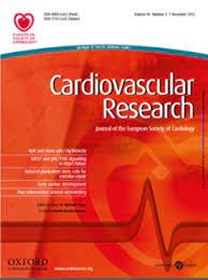左心疾病肺动脉硬化的超声诊断
IF 10.2
1区 医学
Q1 CARDIAC & CARDIOVASCULAR SYSTEMS
引用次数: 0
摘要
目的肺动脉高压(PH)是左心疾病(LHD)的常见并发症,可导致右心衰竭和死亡。肺动脉(PA)硬化最近成为PH的重要诊断和预后参数。本研究旨在建立和验证超声指标,以识别左心疾病(PH- lhd)引起的PH中PA硬化。方法和结果首先,超声硬度指数(US-SI)来源于大鼠模型的肺动脉(PA)径向应变(PA- rs)、直径和脑卒中体积,并与离体测量的“真实”PA硬度e相关。然后,在24例心脏移植前有或没有PH的LHD患者队列中验证US-SI,并再次与收集的PA标本的离体测量的“真实”PA硬度进行比较。在大鼠中,超声PA- rs和US-SI与E密切相关,两者都能以≥80%的灵敏度和特异性检测“真”PA硬化。在LHD患者中,尽管超声右PA径向应变(rPA-RS)或US-SI与E的相关性相似,但观察者评估和诊断有效性测试表明US-SI是更可靠、更准确的方法,能以83.3%的灵敏度和95.8%的特异性检测出“真正的”PA硬化。结论(5)PA应变和US-SI均可超声检测LHD患者或动物模型的PA硬化,但US-SI对PA硬化患者的诊断有效性和准确性更高。临床实施US-SI可以改善LHD患者的风险分层,以及对PH-LHD患者进展或治疗效率的纵向监测。本研究中使用的动物到旁边的方法可以促进临床和临床前情景之间生物和病理力学见解的快速转化。本文章由计算机程序翻译,如有差异,请以英文原文为准。
Identification of pulmonary artery stiffening due to left heart disease by ultrasonography
Aims Pulmonary hypertension (PH) is a common complication of left heart disease (LHD) that leads to right heart failure and death. Pulmonary artery (PA) stiffening has recently emerged as an important diagnostic and prognostic parameter in PH. The present study aimed to develop and validate an ultrasonographic index to identify PA stiffening in PH due to left heart disease (PH-LHD). Methods and Results First, ultrasonographic stiffness index (US-SI) was derived from pulmonary arterial (PA) radial strain (PA-RS), diameter, and stroke volume in rat model, and correlated to ex vivo measured “true” PA stiffness E. Then, US-SI was validated in a cohort of 24 LHD patients with or without PH prior to heart transplantation and again compared to “true” PA stiffness measured ex vivo in collected PA specimens. In rats, ultrasonographic PA-RS and US-SI correlated closely with E, and both were able to detect “true” PA stiffening with ≥ 80% sensitivity and specificity. In LHD patients, even though ultrasonographic right PA radial strain (rPA-RS) or US-SI correlated similarly with E, observer assessment and testing for diagnostic validity identified US-SI as more robust and accurate method that detects “true” PA stiffening with 83.3% sensitivity and 95.8% specificity. Conclusion(s) Both PA strain and US-SI allow for ultrasonographic detection of PA stiffening in patients or animal models with LHD, however, US-SI identifies patients with stiffened PA with higher diagnostic validity and accuracy. Translational Perspective Clinical implementation of US-SI may improve risk stratification in LHD patients and longitudinal monitoring of progression or treatment efficiency in PH-LHD. The animal-to-beside approach used in this study may promote the rapid translation of bio- and pathomechanical insights between the clinical and preclinical scenarios.
求助全文
通过发布文献求助,成功后即可免费获取论文全文。
去求助
来源期刊

Cardiovascular Research
医学-心血管系统
CiteScore
21.50
自引率
3.70%
发文量
547
审稿时长
1 months
期刊介绍:
Cardiovascular Research
Journal Overview:
International journal of the European Society of Cardiology
Focuses on basic and translational research in cardiology and cardiovascular biology
Aims to enhance insight into cardiovascular disease mechanisms and innovation prospects
Submission Criteria:
Welcomes papers covering molecular, sub-cellular, cellular, organ, and organism levels
Accepts clinical proof-of-concept and translational studies
Manuscripts expected to provide significant contribution to cardiovascular biology and diseases
 求助内容:
求助内容: 应助结果提醒方式:
应助结果提醒方式:


